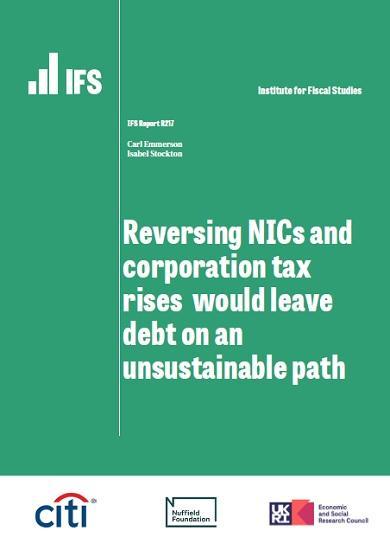Reversing NICs And Corporation Tax Rises Would Leave Debt On An Unsustainable Path
22nd September 2022

From the Institute for Fiscal Studies.
In the ‘mini-Budget' on Friday 23 September, the government is expected to confirm substantial tax-cutting measures reflecting the new Prime Minister Liz Truss's commitments during the leadership campaign. Despite this - and despite the fact that the outlook for the economy is now much weaker than forecast by the Office for Budget Responsibility (OBR) in March - this statement will not be accompanied by new official forecasts for the economy and the public finances. This is disappointing.
The OBR last made a forecast of the public finances back in March. Since then, energy prices and inflation have risen well beyond what was expected, and growth forecasts have slumped. We are forecasting the public finances here based on Citi's latest forecast for growth, inflation and interest rates. This implies a shorter and shallower recession than the Bank of England forecast in August, owing to the substantial support provided to household and business finances by the Energy Price Guarantee. In addition, the rise in the outlook for inflation since March cushions some of the hit to the cash size of the economy - which matters more than its real size for government receipts. Nevertheless, Citi forecasts that the cash economy will be 2% smaller in 2026-27 than the OBR forecast in March.
The fiscal cost of the Energy Price Guarantee is highly uncertain not least because the eventual cost will depend on the path of energy prices and, relatedly, whether the scheme is extended in some form. We assume the Energy Price Guarantee will cost well over £100 billion over the next two years, but that it will then be removed as per the government's stated plan. It could be much more expensive and end up running for more than two years - or much cheaper than we assume.
The cost of reversing the recent rise in rates of National Insurance contributions, and cancelling next April's planned large rise in the rate of corporation tax, is far more certain. Together Ms Truss's tax commitments, if carried out in full, would lead to revenues being about £30 billion a year lower than they would otherwise have been. Since these are large and permanent measures, they also matter more for the long-run health of the public finances than the eventual cost of the Energy Price Guarantee.
Higher inflation will also push up spending on debt interest, state pensions and most working-age benefits. In contrast, spending on public services is set in cash terms, and therefore does not automatically adjust in the light of increased inflation. Previous IFS research has suggested that an additional £18 billion would need to be found in each of the next two years to restore public service spending plans to the real-terms generosity that was intended when the plans were set. In addition, Ms Truss has committed to increasing defence spending to 3% of national income by the end of the decade. Our forecasts do not include any top-up to public service spending plans that were set a year ago; hence there is considerable risk that borrowing will end up higher than our headline estimates suggest.
The combination of higher spending and substantial tax cuts leaves borrowing running at a much higher level than forecast in March. Importantly, even once the Energy Price Guarantee is assumed to have expired in October 2024, our forecast has borrowing running at about £100 billion a year, over £60 billion a year higher than forecast in March. Almost half of this increase in borrowing would be due to the new tax cuts. At around 3.5% of national income, borrowing would be not far off double the 1.9% of national income that it averaged over the 60 years prior to the global financial crisis, when growth prospects were considerably higher. With investment spending running at about 2½% of national income, this would leave a persistent forecast current budget deficit of around 1% of national income. Without new tax cuts, the current budget would have been forecast to remain in balance.
On our forecasts, debt would increase, not just while the Energy Price Guarantee was in place, but also thereafter. Persistent current budget deficits and rising debt as a share of national income means that two main fiscal targets legislated only in January would be missed and that debt would be left on an ever-increasing path. Allowing debt to rise temporarily to finance one-off packages of support, such as the Energy Price Guarantee or the furlough scheme, in exceptional circumstances is justifiable and can be sustainable, but the same case cannot be made for allowing debt to rise indefinitely in order to enjoy lower taxes now.
Finding a way to somehow boost the UK’s rate of economic growth would undoubtedly help. But we should not underestimate the scale of the challenge: an increase in annual growth of more than 0.7% of national income - the increase required just to stabilise debt as a share of GDP at the very end of our forecasts – would be equivalent to the difference between the growth the UK experienced between 1983 and 2008 and that experienced in the 2010s. There is no miracle cure, and setting plans underpinned by the idea that headline tax cuts will deliver a sustained boost to growth is a gamble, at best.
Note
Read the full report HERE
